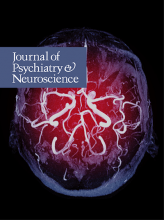Research Paper
White matter network alterations in patients with depersonalization/derealization disorder
Anika Sierk, Judith K. Daniels, Antje Manthey, Jelmer G. Kok, Alexander Leemans, Michael Gaebler, Jan-Peter Lamke, Johann Kruschwitz and Henrik Walter
J Psychiatry Neurosci September 01, 2018 43 (5) 347-357; DOI: https://doi.org/10.1503/jpn.170110
Anika Sierk
From the Charité – Universitätsmedizin Berlin, corporate member of Freie Universität Berlin, Humboldt-Universität zu Berlin, and Berlin Institute of Health, Berlin, Germany (Sierk, Manthey, Lamke, Kruschwitz, Walter); the Institute of Cognitive Neuroscience, University College London, London, UK (Sierk); the Department of Clinical Psychology, University of Groningen, Groningen, The Netherlands (Daniels); the Department of Neurology, University of Groningen, University Medical Center Groningen, The Netherlands (Kok); the PROVIDI Lab, University Medical Center Utrecht, Utrecht, the Netherlands (Leemans); and the Max Planck Institute for Human Cognitive and Brain Sciences, Leipzig, Germany (Gaebler)
PhD (candidate)Judith K. Daniels
From the Charité – Universitätsmedizin Berlin, corporate member of Freie Universität Berlin, Humboldt-Universität zu Berlin, and Berlin Institute of Health, Berlin, Germany (Sierk, Manthey, Lamke, Kruschwitz, Walter); the Institute of Cognitive Neuroscience, University College London, London, UK (Sierk); the Department of Clinical Psychology, University of Groningen, Groningen, The Netherlands (Daniels); the Department of Neurology, University of Groningen, University Medical Center Groningen, The Netherlands (Kok); the PROVIDI Lab, University Medical Center Utrecht, Utrecht, the Netherlands (Leemans); and the Max Planck Institute for Human Cognitive and Brain Sciences, Leipzig, Germany (Gaebler)
PhDAntje Manthey
From the Charité – Universitätsmedizin Berlin, corporate member of Freie Universität Berlin, Humboldt-Universität zu Berlin, and Berlin Institute of Health, Berlin, Germany (Sierk, Manthey, Lamke, Kruschwitz, Walter); the Institute of Cognitive Neuroscience, University College London, London, UK (Sierk); the Department of Clinical Psychology, University of Groningen, Groningen, The Netherlands (Daniels); the Department of Neurology, University of Groningen, University Medical Center Groningen, The Netherlands (Kok); the PROVIDI Lab, University Medical Center Utrecht, Utrecht, the Netherlands (Leemans); and the Max Planck Institute for Human Cognitive and Brain Sciences, Leipzig, Germany (Gaebler)
Jelmer G. Kok
From the Charité – Universitätsmedizin Berlin, corporate member of Freie Universität Berlin, Humboldt-Universität zu Berlin, and Berlin Institute of Health, Berlin, Germany (Sierk, Manthey, Lamke, Kruschwitz, Walter); the Institute of Cognitive Neuroscience, University College London, London, UK (Sierk); the Department of Clinical Psychology, University of Groningen, Groningen, The Netherlands (Daniels); the Department of Neurology, University of Groningen, University Medical Center Groningen, The Netherlands (Kok); the PROVIDI Lab, University Medical Center Utrecht, Utrecht, the Netherlands (Leemans); and the Max Planck Institute for Human Cognitive and Brain Sciences, Leipzig, Germany (Gaebler)
PhDAlexander Leemans
From the Charité – Universitätsmedizin Berlin, corporate member of Freie Universität Berlin, Humboldt-Universität zu Berlin, and Berlin Institute of Health, Berlin, Germany (Sierk, Manthey, Lamke, Kruschwitz, Walter); the Institute of Cognitive Neuroscience, University College London, London, UK (Sierk); the Department of Clinical Psychology, University of Groningen, Groningen, The Netherlands (Daniels); the Department of Neurology, University of Groningen, University Medical Center Groningen, The Netherlands (Kok); the PROVIDI Lab, University Medical Center Utrecht, Utrecht, the Netherlands (Leemans); and the Max Planck Institute for Human Cognitive and Brain Sciences, Leipzig, Germany (Gaebler)
PhDMichael Gaebler
From the Charité – Universitätsmedizin Berlin, corporate member of Freie Universität Berlin, Humboldt-Universität zu Berlin, and Berlin Institute of Health, Berlin, Germany (Sierk, Manthey, Lamke, Kruschwitz, Walter); the Institute of Cognitive Neuroscience, University College London, London, UK (Sierk); the Department of Clinical Psychology, University of Groningen, Groningen, The Netherlands (Daniels); the Department of Neurology, University of Groningen, University Medical Center Groningen, The Netherlands (Kok); the PROVIDI Lab, University Medical Center Utrecht, Utrecht, the Netherlands (Leemans); and the Max Planck Institute for Human Cognitive and Brain Sciences, Leipzig, Germany (Gaebler)
PhDJan-Peter Lamke
From the Charité – Universitätsmedizin Berlin, corporate member of Freie Universität Berlin, Humboldt-Universität zu Berlin, and Berlin Institute of Health, Berlin, Germany (Sierk, Manthey, Lamke, Kruschwitz, Walter); the Institute of Cognitive Neuroscience, University College London, London, UK (Sierk); the Department of Clinical Psychology, University of Groningen, Groningen, The Netherlands (Daniels); the Department of Neurology, University of Groningen, University Medical Center Groningen, The Netherlands (Kok); the PROVIDI Lab, University Medical Center Utrecht, Utrecht, the Netherlands (Leemans); and the Max Planck Institute for Human Cognitive and Brain Sciences, Leipzig, Germany (Gaebler)
PhDJohann Kruschwitz
From the Charité – Universitätsmedizin Berlin, corporate member of Freie Universität Berlin, Humboldt-Universität zu Berlin, and Berlin Institute of Health, Berlin, Germany (Sierk, Manthey, Lamke, Kruschwitz, Walter); the Institute of Cognitive Neuroscience, University College London, London, UK (Sierk); the Department of Clinical Psychology, University of Groningen, Groningen, The Netherlands (Daniels); the Department of Neurology, University of Groningen, University Medical Center Groningen, The Netherlands (Kok); the PROVIDI Lab, University Medical Center Utrecht, Utrecht, the Netherlands (Leemans); and the Max Planck Institute for Human Cognitive and Brain Sciences, Leipzig, Germany (Gaebler)
PhDHenrik Walter
From the Charité – Universitätsmedizin Berlin, corporate member of Freie Universität Berlin, Humboldt-Universität zu Berlin, and Berlin Institute of Health, Berlin, Germany (Sierk, Manthey, Lamke, Kruschwitz, Walter); the Institute of Cognitive Neuroscience, University College London, London, UK (Sierk); the Department of Clinical Psychology, University of Groningen, Groningen, The Netherlands (Daniels); the Department of Neurology, University of Groningen, University Medical Center Groningen, The Netherlands (Kok); the PROVIDI Lab, University Medical Center Utrecht, Utrecht, the Netherlands (Leemans); and the Max Planck Institute for Human Cognitive and Brain Sciences, Leipzig, Germany (Gaebler)
PhD
Submit a Response to This Article
Jump to comment:
No Responses have been published for this article.
In this issue
J Psychiatry Neurosci
Vol. 43, Issue 5
1 Sep 2018
Article tools
White matter network alterations in patients with depersonalization/derealization disorder
Anika Sierk, Judith K. Daniels, Antje Manthey, Jelmer G. Kok, Alexander Leemans, Michael Gaebler, Jan-Peter Lamke, Johann Kruschwitz, Henrik Walter
J Psychiatry Neurosci Sep 2018, 43 (5) 347-357; DOI: 10.1503/jpn.170110
White matter network alterations in patients with depersonalization/derealization disorder
Anika Sierk, Judith K. Daniels, Antje Manthey, Jelmer G. Kok, Alexander Leemans, Michael Gaebler, Jan-Peter Lamke, Johann Kruschwitz, Henrik Walter
J Psychiatry Neurosci Sep 2018, 43 (5) 347-357; DOI: 10.1503/jpn.170110
Related Articles
Cited By...
- No citing articles found.








